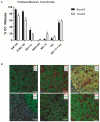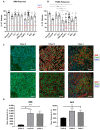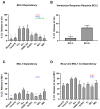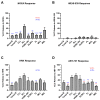Apoptotic Blocks in Primary Non-Hodgkin B Cell Lymphomas Identified by BH3 Profiling
- PMID: 33670870
- PMCID: PMC7957722
- DOI: 10.3390/cancers13051002
Apoptotic Blocks in Primary Non-Hodgkin B Cell Lymphomas Identified by BH3 Profiling
Abstract
To determine causes of apoptotic resistance, we analyzed 124 primary B cell NHL samples using BH3 profiling, a technique that measures the mitochondrial permeabilization upon exposure to synthetic BH3 peptides. Our cohort included samples from chronic lymphocytic leukemia (CLL), follicular lymphoma (FL), diffuse large B-cell lymphoma (DLBCL), high-grade B cell lymphoma with translocations in MYC and BCL2 (HGBL-DH), mantle cell lymphoma (MCL) and marginal zone lymphoma (MZL). While a large number of our samples displayed appropriate responses to apoptosis-inducing peptides, pro-apoptotic functional defects, implicating BAX, BAK, BIM or BID, were seen in 32.4% of high-grade NHLs (12/37) and in 3.4% of low-grade NHLs (3/87, p < 0.0001). The inhibition of single anti-apoptotic proteins induced apoptosis in only a few samples, however, the dual inhibition of BCL2 and MCL1 was effective in 83% of samples, indicating MCL1 was the most common cause of lack of response to the BCL2 inhibitor, venetoclax. We then profiled Toledo and OCI-Ly8 high-grade lymphoma cell lines to determine which drugs could reduce MCL1 expression and potentiate venetoclax responses. Doxorubicin and vincristine decreased levels of MCL1 and increased venetoclax-induced apoptosis (all p < 0.05). Overall, in primary NHLs expressing BCL2 that have no defects in pro-apoptotic signaling, a poor response to venetoclax is primarily due to the presence of MCL1, which may be overcome by combining venetoclax with doxorubicin and vincristine-based chemotherapy or with other anti-microtubule inhibitors.
Keywords: BCL2; BH3 profiling; DLBCL; MCL1; NHL; apoptosis; venetoclax.
Conflict of interest statement
N.A.J. has received research funding from Roche Canada and consulting fees/honoraria from Roche, Abbvie, Lundbeck, Seattle Genetics, Janssen, and Gilead. At the time of submission, C.M.W. is employed by Astrazeneca plc. A.L. discloses consulting and laboratory research support from AbbVie, Novartis, and Astrazeneca. He is an equity-holding co-founder of Flash Therapeutics and Vivid Biosciences.
Figures







Similar articles
-
Targeting BCL2 with venetoclax is a promising therapeutic strategy for "double-proteinexpression" lymphoma with MYC and BCL2 rearrangements.Haematologica. 2019 Jul;104(7):1417-1421. doi: 10.3324/haematol.2018.204958. Epub 2018 Dec 6. Haematologica. 2019. PMID: 30523053 Free PMC article.
-
Anti-apoptotic MCL1 Protein Represents Critical Survival Molecule for Most Burkitt Lymphomas and BCL2-negative Diffuse Large B-cell Lymphomas.Mol Cancer Ther. 2022 Jan;21(1):89-99. doi: 10.1158/1535-7163.MCT-21-0511. Epub 2021 Nov 2. Mol Cancer Ther. 2022. PMID: 34728569 Free PMC article.
-
BCL-2 Proteins in Pathogenesis and Therapy of B-Cell Non-Hodgkin Lymphomas.Cancers (Basel). 2020 Apr 10;12(4):938. doi: 10.3390/cancers12040938. Cancers (Basel). 2020. PMID: 32290241 Free PMC article. Review.
-
Cotargeting of BCL2 with Venetoclax and MCL1 with S63845 Is Synthetically Lethal In Vivo in Relapsed Mantle Cell Lymphoma.Clin Cancer Res. 2019 Jul 15;25(14):4455-4465. doi: 10.1158/1078-0432.CCR-18-3275. Epub 2019 Apr 19. Clin Cancer Res. 2019. PMID: 31004002
-
BH3 Mimetics for the Treatment of B-Cell Malignancies-Insights and Lessons from the Clinic.Cancers (Basel). 2020 Nov 12;12(11):3353. doi: 10.3390/cancers12113353. Cancers (Basel). 2020. PMID: 33198338 Free PMC article. Review.
Cited by
-
Microfluidic-based dynamic BH3 profiling predicts anticancer treatment efficacy.NPJ Precis Oncol. 2022 Dec 1;6(1):90. doi: 10.1038/s41698-022-00333-0. NPJ Precis Oncol. 2022. PMID: 36456699 Free PMC article.
-
Genetic Events Inhibiting Apoptosis in Diffuse Large B Cell Lymphoma.Cancers (Basel). 2021 Apr 30;13(9):2167. doi: 10.3390/cancers13092167. Cancers (Basel). 2021. PMID: 33946435 Free PMC article. Review.
-
EIF4A inhibition targets bioenergetic homeostasis in AML MOLM-14 cells in vitro and in vivo and synergizes with cytarabine and venetoclax.J Exp Clin Cancer Res. 2022 Dec 9;41(1):340. doi: 10.1186/s13046-022-02542-8. J Exp Clin Cancer Res. 2022. PMID: 36482393 Free PMC article.
-
The mitochondrial anti-apoptotic dependencies of hematologic malignancies: from disease biology to advances in precision medicine.Haematologica. 2022 Apr 1;107(4):790-802. doi: 10.3324/haematol.2021.280201. Haematologica. 2022. PMID: 35045693 Free PMC article. Review.
-
Scalable lipid droplet microarray fabrication, validation, and screening.PLoS One. 2024 Jul 5;19(7):e0304736. doi: 10.1371/journal.pone.0304736. eCollection 2024. PLoS One. 2024. PMID: 38968248 Free PMC article.
References
-
- Swerdlow S.H., Campo E., Pileri S.A., Harris N.L., Stein H., Siebert R., Advani R., Ghielmini M., Salles G.A., Zelenetz A.D., et al. The 2016 revision of the World Health Organization classification of lymphoid neoplasms. Blood. 2016;127:2375–2390. doi: 10.1182/blood-2016-01-643569. - DOI - PMC - PubMed
-
- Johnson N.A., Slack G.W., Savage K.J., Connors J.M., Ben-Neriah S., Rogic S., Scott D.W., Tan K.L., Steidl C., Sehn L.H., et al. Concurrent expression of MYC and BCL2 in diffuse large B-cell lymphoma treated with rituximab plus cyclophosphamide, doxorubicin, vincristine, and prednisone. J. Clin. Oncol. 2012;30:3452–3459. doi: 10.1200/JCO.2011.41.0985. - DOI - PMC - PubMed
-
- Green T.M., Young K.H., Visco C., Xu-Monette Z.Y., Orazi A., Go R.S., Nielsen O., Gadeberg O.V., Mourits-Andersen T., Frederiksen M., et al. Immunohistochemical double-hit score is a strong predictor of outcome in patients with diffuse large B-cell lymphoma treated with rituximab plus cyclophosphamide, doxorubicin, vincristine, and prednisone. J. Clin. Oncol. 2012;30:3460–3467. doi: 10.1200/JCO.2011.41.4342. - DOI - PubMed
Grants and funding
LinkOut - more resources
Full Text Sources
Other Literature Sources
Research Materials

